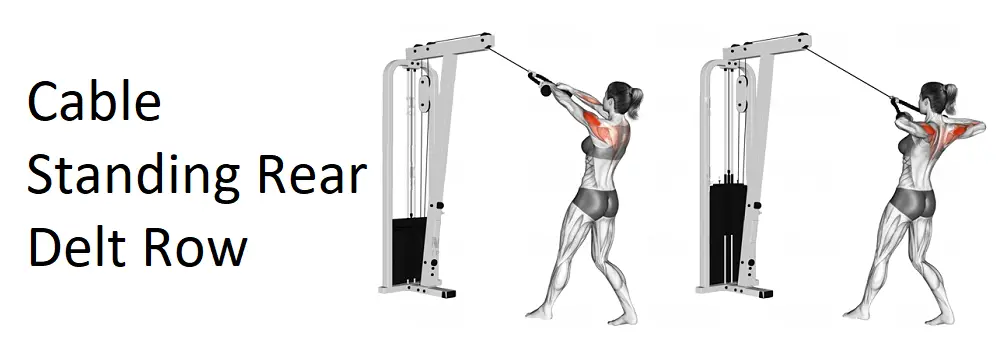Table of Contents
Introduction
The Cable Standing Rear Delt Row is a versatile exercise that uses a cable machine to isolate the rear deltoid muscles and upper back. Unlike free-weight movements, the cable provides continuous tension throughout the exercise, making it an excellent choice for building strength and definition in the rear delts and improving shoulder health.
This exercise is ideal for individuals aiming to correct shoulder imbalances, enhance upper body aesthetics, or support compound lifts like the bench press and deadlift by strengthening the posterior deltoids and scapular stabilizers.
Instructions: How to Perform Cable Standing Rear Delt Row
To perform the Cable Standing Rear Delt Row correctly, follow these steps:
- Setup:
- Attach a rope handle to a cable machine at chest height.
- Stand facing the machine with your feet shoulder-width apart.
- Grab the ends of the rope with a neutral grip (palms facing each other).
- Engage Core and Set Posture:
- Stand upright with a slight bend in your knees.
- Keep your chest up, shoulders back, and core engaged.
- Pull the Rope Towards Your Face:
- Initiate the movement by pulling your elbows outward and backward.
- Focus on squeezing your shoulder blades together as you bring the rope towards your face.
- Stop when your upper arms are parallel to the floor and your elbows are in line with your shoulders.
- Controlled Release:
- Slowly extend your arms to return to the starting position, maintaining control of the weight.
- Repetitions:
- Aim for 10–15 reps and perform 3–4 sets.
Pro Tips:
- Avoid shrugging your shoulders; keep them relaxed throughout the movement.
- Maintain a slight bend in your elbows to protect the joints.
- Keep the motion slow and controlled to maximize muscle engagement.
Benefits of Cable Standing Rear Delt Row
The Cable Standing Rear Delt Row offers numerous benefits, including:
- Targets the Rear Deltoids: It isolates the rear delts effectively, which are often neglected in traditional shoulder workouts.
- Improves Posture: Strengthening the rear delts and upper back helps counteract forward shoulder rounding caused by prolonged sitting or poor posture.
- Enhances Shoulder Stability: Strong rear delts and scapular stabilizers reduce the risk of shoulder injuries and enhance performance in other lifts.
- Provides Continuous Tension: The cable machine offers consistent resistance throughout the range of motion, leading to better muscle activation.
- Versatile and Adjustable: The cable machine allows you to modify resistance easily, making the exercise suitable for all fitness levels.
Muscles Worked in Cable Standing Rear Delt Row
This exercise primarily targets the rear deltoids and also engages several supporting muscles:
- Posterior Deltoid (Rear Delt): The main muscle worked, responsible for shoulder extension and horizontal abduction.
- Rhomboids: Assist in retracting the shoulder blades, stabilizing the scapula.
- Trapezius (Upper and Middle Fibers): Supports scapular movement and shoulder stability.
- Biceps Brachii: Engaged as a secondary muscle during the pulling motion.
- Rotator Cuff Muscles: Help stabilize the shoulder joint throughout the exercise.
Video on How to Do Cable Standing Rear Delt Row
Other Names for Cable Standing Rear Delt Row
This exercise may also be known as:
- Cable Rear Delt Pull
- Standing Cable Reverse Row
- Rope Rear Delt Row
These names may vary but refer to the same movement targeting the rear delts using a cable machine.
FAQs
1. Can beginners perform the Cable Standing Rear Delt Row?
Yes, this exercise is beginner-friendly. Start with a lighter weight to master proper form before increasing resistance.
2. Is the Cable Standing Rear Delt Row better than free-weight rear delt exercises?
The cable version provides continuous tension throughout the range of motion, which can result in better muscle activation. Free-weight exercises, like dumbbell reverse flyes, offer more range of motion variability. Both are effective and can be included in your routine.
3. Should I lean forward during this exercise?
No, you should maintain an upright posture. Leaning forward may shift the focus away from the rear delts.
4. How often should I include this exercise in my workout?
Incorporate it 1–2 times per week as part of a shoulder or upper back routine.
5. Can I use a different attachment besides the rope?
Yes, you can use a straight bar or single handles, but the rope attachment allows for a more natural range of motion.
Conclusion
The Cable Standing Rear Delt Row is an excellent exercise for isolating and strengthening the rear deltoids, improving shoulder stability, and enhancing posture. Its versatility and continuous tension make it a superior choice for building well-rounded shoulders and a balanced upper back.
Whether you’re a beginner or an advanced lifter, this exercise can be easily adjusted to suit your fitness level and goals. Consistently including it in your routine will help you achieve stronger, more defined shoulders and improve performance in other upper-body exercises.








